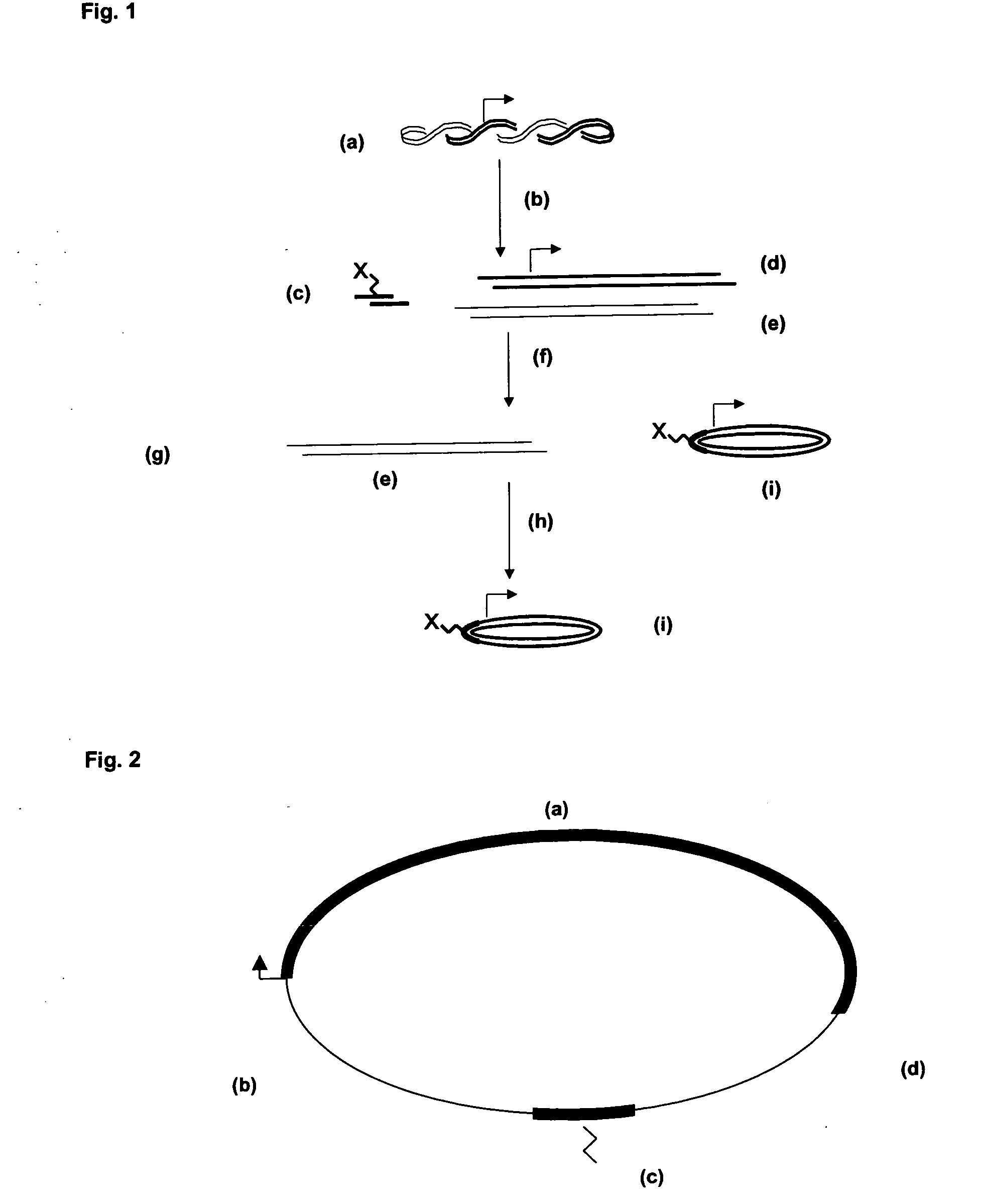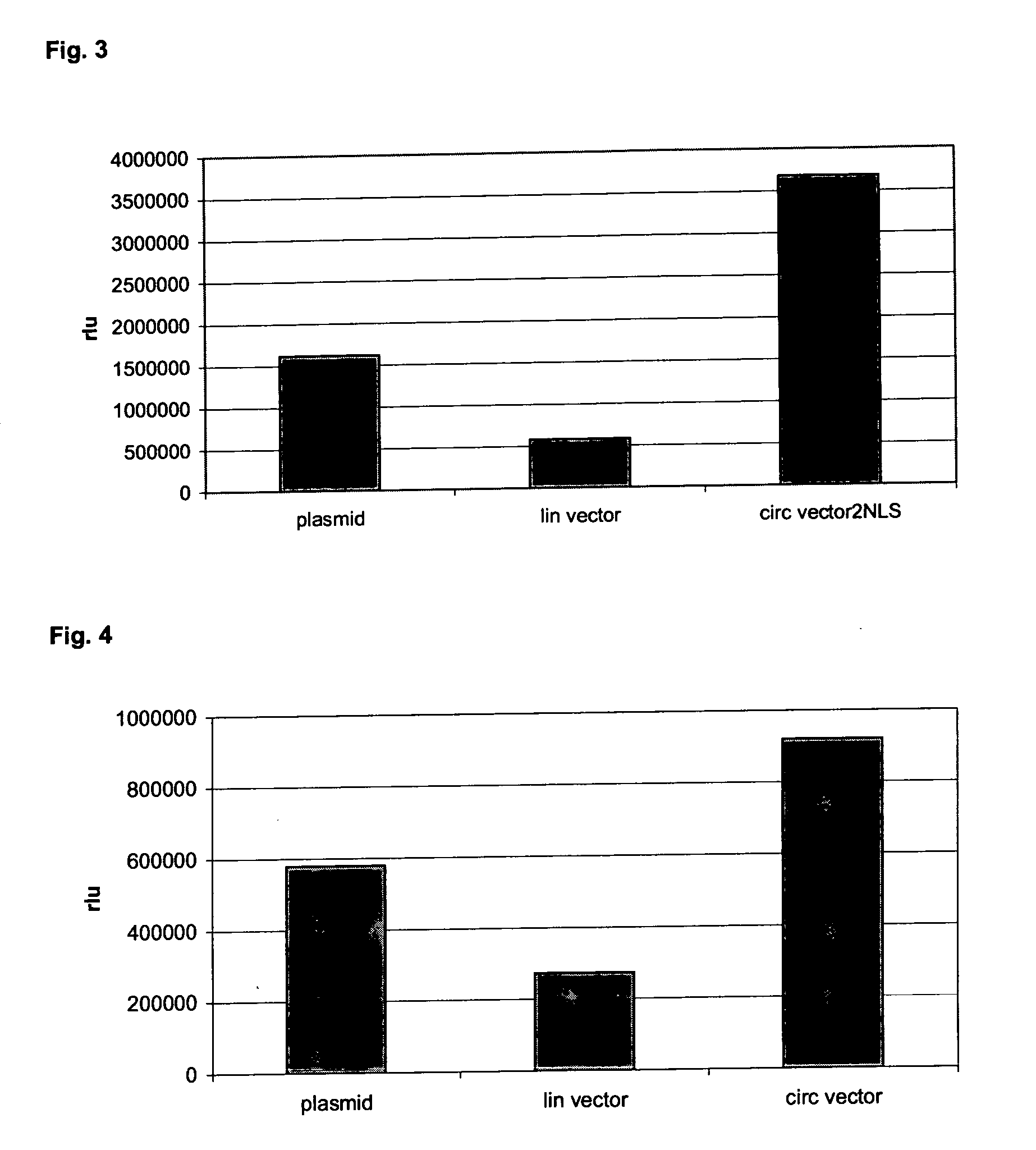Circular expression construct for gene therapeutic applications
a gene and expression technology, applied in the direction of antiparasitic agents, drug compositions, peptide sources, etc., can solve the problems of virus in gene therapy, insufficient transfection efficiency, rare and relatively unpredictable process of dna transfection,
- Summary
- Abstract
- Description
- Claims
- Application Information
AI Technical Summary
Benefits of technology
Problems solved by technology
Method used
Image
Examples
example 1
Production of Circular Vectors
[0086] The plasmid pMOK-Luc was completely digested with the restriction enzyme Eco3 μl for 2 h at 37° C. The restriction digestion created two DNA fragments. One comprised the canamycin resistance gene as well as other sequences necessary for plasmid propagation, and the other fragment consisted of the sequences that should form the vector according to at least one embodiment, namely CMV promotor, the gene sequence to be expressed and the polyadenylation sequence from SV-40. By the enzyme T4-DNA-ligase (in ligase buffer: 400 mM Tris-HCL, 100 mM MgCL2, 5 mM ATP) the complementary ends produced by Eco31l were ligated over night at 4° C. to each other. The resulting mixture of nucleic acids was treated with the enzyme Eco147l. For degradation of resting DNA with vector origin the enzyme T7 DNA polymerase was added to the mixture. The remaining circular expression cassette was purified by anion exchange chromatography and was precipitated with isopropanol...
example 2a
[0088] Circular expression cassettes with coupled peptides were constructed as follows: The NLS peptide PKKKRKV (poline-lysine-lysine-lysine-arginine-lysine-valina) was coupled in two steps whether to one or both oligonucleotides. First the modified oligonucleotide (5′-PH-d(GGGAACCTTCAGTxAGCAATGG respectively 5′-PH-d AGGGCCATTGCTxACTGAAGG, where xT represents a amino-modified thymine-base with C2 amino-linker) (0.1 mM) was activated with sulfo-KMUS (5 mM) in coupling buffer (50 mM NaPO4 and 75 mM NaCl, 0.5×, pH 7.6) at 37° C. for 2 h. The reaction was stopped with 50 mM Tris(hydroxymethyl)aminomethane (pH 7.5) and the activated ODN was received after ethanol precipitation (300 mM NaOAc pH 5.2, 5.5 mM MgCl2, 100% ethanol), centrifugation and a single washing step with 70% ethanol. The ODN (0.1 mM) received by this was solved in coupling buffer (50 mM NaPO4 und 75 mM NaCl, 0.5×, pH7.0) and reacted with the peptide (0.2 mM) for one hour at 37° C. The reaction was checke...
example 2b
Production of Circular Vectors with Peptide Coupling
[0089] The plasmid pMOK-Luc was completely digested with the restriction enzyme Eco31l for 2 h at 37° C. The restriction digestion created two DNA fragments. By the enzyme T4 DNA ligase the previously at 90° C. or 3 min hybridized, complementary, 5′-phosphorylated oligodeoxynucleotides (TIBMolBiol, Berlin) 5′-PH-GGGAACCTTCAGTxAGCAATGG-3′ and 5′ PH-AGGGCCATTGCTxACTGAAGG-3′ (xT represents an amino-modified thymine-base with C2 linker, to which by choice the signal peptide NLS was covalently coupled) was ligated in presence of the restriction enzyme Eco31l over night at 4° C. to the vector forming fragment (compare example 1). The resulting mixture of nucleic acids was treated with the enzyme T7 DNA polymerase. The product was purified by anion exchange chromatography and precipitated with isopropanol.
PUM
| Property | Measurement | Unit |
|---|---|---|
| pH | aaaaa | aaaaa |
| pH | aaaaa | aaaaa |
| pH | aaaaa | aaaaa |
Abstract
Description
Claims
Application Information
 Login to View More
Login to View More - R&D
- Intellectual Property
- Life Sciences
- Materials
- Tech Scout
- Unparalleled Data Quality
- Higher Quality Content
- 60% Fewer Hallucinations
Browse by: Latest US Patents, China's latest patents, Technical Efficacy Thesaurus, Application Domain, Technology Topic, Popular Technical Reports.
© 2025 PatSnap. All rights reserved.Legal|Privacy policy|Modern Slavery Act Transparency Statement|Sitemap|About US| Contact US: help@patsnap.com



